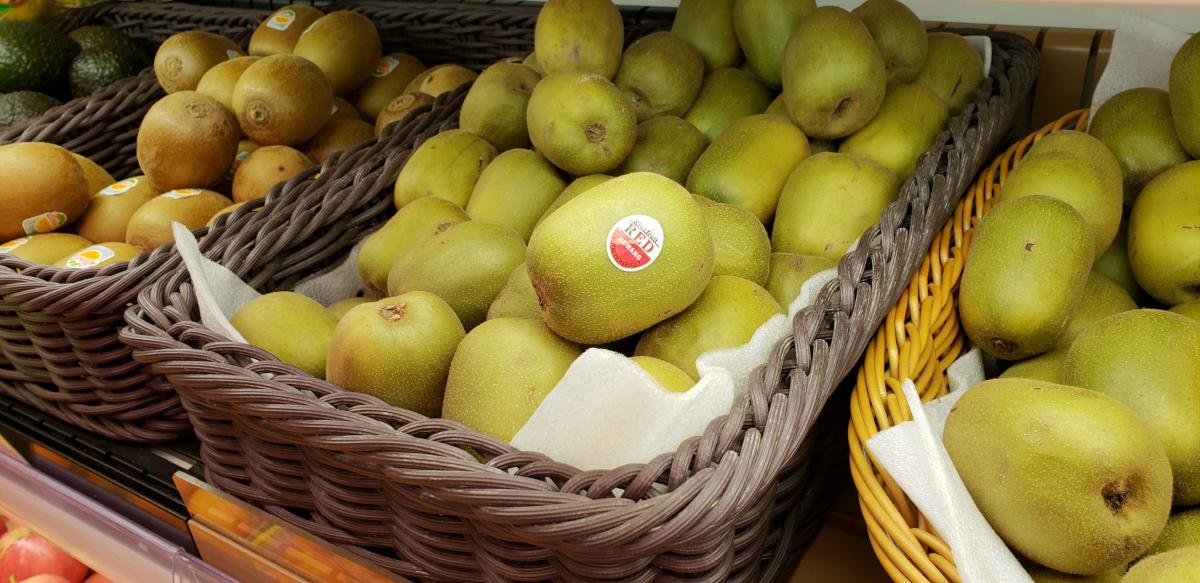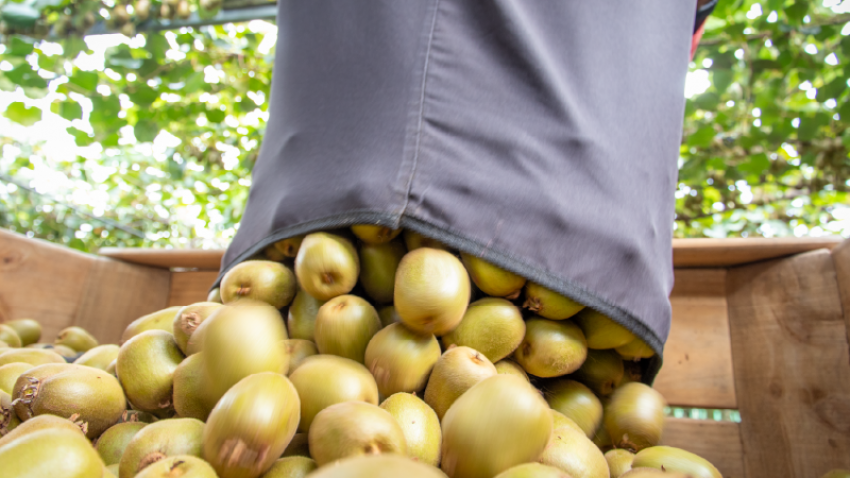You are here
Back to topExclusive Analysis: The Obstacles Facing China's World-Leading Kiwifruit Industry in 2018

Domestically produced red-hearted kiwifruit on sale in a Chinese supermarket, alongside imported Zespri brand kiwifruit. Image: MZMC
As the new season’s kiwifruit crop started to come online in China over the past few months, growers and wholesalers were surely hoping that 2017 – the first time in ten years that domestic kiwifruit prices had seen a year-on-year drop – was an aberration.
But early season results for 2018 were disappointing overall, with a general trend of lower year-on-year prices reported across all major kiwifruit-producing regions. In Sichuan province, early-season prices for red-hearted kiwifruit were around 20% lower than last year. In Shaanxi province, prices for the widely-planted Xuxiang green cultivar were down 30% amidst generally weak prices across all kiwifruit varieties. This was despite depressed output this season in these two key regions due to cold snaps and flooding.
The trend of slumping prices is a sign of major trouble for the kiwifruit industry in China, which produced 2.4 million tons of kiwifruit in 2016, more than half the global total. Following, Produce Report analyzes some of the key challenges facing the kiwifruit industry and reasons behind the weak prices so far this season.
Basic Supply and Demand
Shifts in the balance of supply and demand are a major challenge to China’s kiwifruit industry. Some years ago, kiwifruit was a niche fruit that was growing in popularity. As rising demand chased a small supply, prices rose continuously until a peak in 2016.
But, in the background, rising prices were setting the stage for a supply glut as farmers and local government officials in areas across China simultaneously identified what they considered to be a highly profitable fruit and tried to grab a piece of the action. Over a period of just a few years, fueled by government initiatives, policy support, and industrial farming projects, the area in China devoted to kiwifruit plantation doubled, exceeding 160,000ha. In 2017 – the year prices finally started falling – per capita kiwifruit production had already exceeded 2kg (China exports very few fresh kiwifruit, only 4,297 tons in 2017, mostly to Russia). The trend of increased plantation seems to be ongoing and poised to exacerbate China’s domestic kiwifruit oversupply problem.
The rapid expansion of plantation into new regions has hurt traditional kiwifruit growing clusters in, for example, Sichuan’s Cangxi county, Shaanxi’s Meixian county and Hunan’s Yongshun county. For example, this year when those traditional growing clusters experienced poor output because of weather events, growers could not get a higher price for their smaller crop because purchasers simply turned to emerging production clusters to plug the supply gap.
Inconsistency and Deficiencies in Cultivation
Growing techniques and horticultural sophistication vary widely among Chinese kiwifruit producers. One farmer may turn out fruit that are excellent in every aspect except storability; another may grow poor quality fruit year in and year out, but refuse to abandon “traditional” cultivation techniques. Often, due to a lack of standards, technical know-how and systematic management, it’s hard to say why a particular orchard turned out good fruit and another turned out poor-quality fruit. This fragmented and unreliable production makes standardization and branding difficult for domestic kiwifruit in China.
Lack of Professional Supply Chain Management
China lacks specialist services in post-harvest management of kiwifruit. Picking, transport, and cold storage are not managed in a comprehensive fashion. Especially, the supply chain does a poor job of predicting and responding to the individual storage and disease prevention needs of different kiwifruit varieties. Postharvest treatments are applied by gut instinct rather than standardized formulas. These issues in the supply chain are compounded by the aforementioned problems with cultivation to increase the quality loss incurred before the fruit arrives at a retailer. This leads to a short shelf life at the retailer and a bad consumer experience due to a high rate of fruits that are either subpar or inedible. In turn, consumers may develop a lack of trust in the quality of domestically produced kiwifruit.
Retail: Ecommerce is a Two-Edged Sword
Ecommerce has contributed to the development of China’s kiwifruit industry and consumption, but it’s a two-edged sword. On one hand, the rapid emergence of ecommerce has helped to move huge volumes of kiwifruit in recent years and cultivated a habit of kiwifruit consumption in new consumer segments. But, on the other hand, fruit ecommerce in China is often strongly driven by price competition. With marketing expenditures continuously rising, fruit ecommerce operators face a lot of pressure to buy the cheapest product possible. Again, as with poor quality fruit sold by brick and mortar retailers, just one bad experience risks tarnishing the image of domestic kiwifruit in the eyes of consumers, and they will not try buying again.
Domestic vs Imported Kiwifruit in China
In contrast to the troubles faced by domestic kiwifruit, imported offerings from Zespri of New Zealand are performing very well in the China market. Zespri reported sales in China of RMB 2.4 billion (US$338 million) in its most recent fiscal year, with China reportedly surpassing Japan as Zespri’s top market. Zespri hopes to double its sales in China over the next four years.
The success of imported kiwifruit in China provides a convincing argument that demand is continuing to grow in the high end of the market, but that domestic growers are simply not producing fruit that is good enough to satisfy these consumers’ needs. In order to take a piece of the high end and start to address its problems with oversupply, slumping prices and eroded consumer trust, domestic China kiwifruit producers need to expand branding efforts, build an integrated kiwifruit supply chain, and improve on cultivation techniques, post-harvest treatment, fruit storage and product standardization.
A version of this article was originally published in Chinese. Read the original here. 参照中文原版。















Add new comment